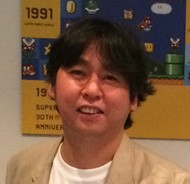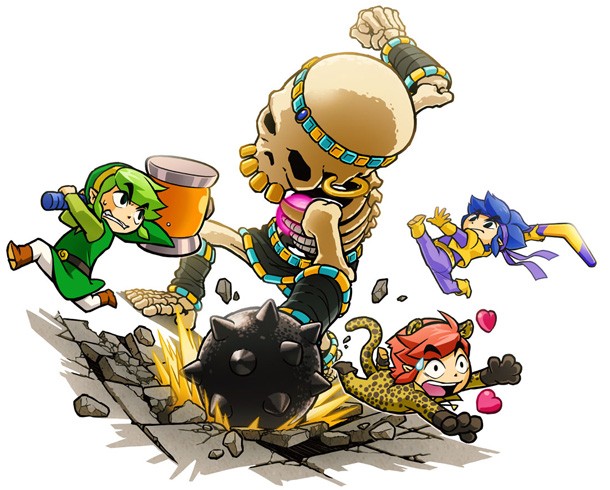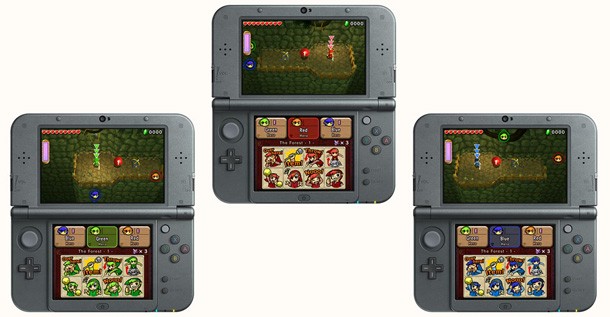Tri-Force Heroes' Director On Zelda: Four Swords Inspirations And Ocarina Of Time

During E3 last month, we had a chance to speak with the director of The Legend of Zelda: Tri-Force Heroes, Hiromasa Shikata. Shikata most recently directed the critically acclaimed The Legend of Zelda: A Link Between Worlds. He has been involved with the Zelda series since Ocarina of Time, and hasn't strayed far from Nintendo's venerated franchise during his time with the company.
We spoke with Shikata about where Tri-Force heroes takes place in the Zelda timeline (though he didn't have much to offer), how Four Swords factored into the game's development, and about his history with the Zelda series focusing on Ocarina of time.

Where does Triforce Heroes take place in the Zelda timeline?
That’s a tough question. The Zelda timeline is quite complicated if you look at the history of Zelda I think you can see there are three branches. I can’t really designate which one of those branches we’re looking at, but as far as the design itself, it really is Link Between Worlds. But it’s not – as far as a timeframe – before or after. We haven’t really settled on or said that.
Does it take place in the same universe or world as A Link Between Worlds?
Again, with the history of Zelda we have these three parallel worlds. I can’t say which one it’s in at this point.
It seems like Four Swords is the main inspiration for Triforce Heroes.
There are points where you could definitely say that, but there are other points where, no, it’s not at all. We have the overall producer of the Zelda series, Mr. Eiji Aonuma, with four swords of course he incorporated multiplayer gameplay elements, but if you go back, his first title, Marvelous, also had multiplayer.
As for myself, I was the lead game designer on The Legend of Zelda: Spirit Tracks, and within that game we had the phantom Link element where you switched back and forth between controlling the phantom and Link and I was always interested in that type of gameplay, but not with a person switching between two, but with two people.
So, I didn’t come up with the idea or suggest the idea for Tri-Force Heroes because I wanted to do a sequel to Four Swords.
Why three and not four players? Is it just the magic number? Or is it just thematic for Zelda’s triforce?
Mr. Aonuma of course had Four Swords, and I had Spirit Tracks which had two players – so I just went with the one right in the middle. (laughs) That’s a joke actually.
I really wanted to adopt and use the camera we had in A Link Between Worlds because it worked so well with the 3D feature of the 3DS. Because of the way that camera works, and because we wanted to incorporate an element of height within the gameplay, we thought, “What’s one way we can take advantage of the fact that you can see that depth?” And so the idea came about of stacking things. Of course, when we’re talking about stacking things, we’re talking about having the characters stand on each other’s shoulders. We played around with the idea of four players, but to be honest, it just seemed too high. It was a little difficult to see and it just didn’t really quite get what we were going at, so we reduced it down to three.
There was a huge hurdle of accessibility when it came to Four Swords – getting people together with all the right hardware, etc. Did you keep this in mind when developing Tri-Force Heroes?
Not really, we just thought, “We want to do a multiplayer game. What’s the best approach?” It wasn’t like a, “Hey, this was a problem then. Let’s make sure we don’t repeat it.” We had a fresh start.
Is there a narrative to the game?
I can give you a brief overview. The story takes place in a world that is not Hyrule, but in a kingdom that is fashion-obsessed. In that kingdom, an event happens. The event involving the princess of the kingdom…
Is her name Zelda?
No. The king, of course, wants to solve this problem – to circumvent this happening – so he makes a general call out to the kingdom for heroes to assemble. Who answers the call? Link. And that’s the beginning of your adventure.
For details on the limitation of multiplayer, head to page two.

Between this and Splatoon. It seems fashion is becoming very important for Nintendo. Is that an expectation from management? Or just a coincidence?
Let me talk about why fashion is important for Tri-Force Heroes. In A Link Between Worlds, there were these alien type things you would collect to power up items. I really liked that mechanic of collecting things to power up existing items. It’s not just powering up items – I wanted to do more than that. So in this game you will see things other than items. Things that will make you immune to fire, swim faster, something that will make more rupees appear. The easiest way to represent that in the game, I thought, would be through clothing. I thought that, depending on which clothing you collected, it would impact how you navigated courses and would make them easier to move through. It’s not something as simple as this will make a stronger attacker, or this will give you a better defense. They’re really designed toward making you be able to navigate and clear a course. That would be things like being able to shoot three arrows at a time, or being immune to lava.
Will we see costumes fashioned after other Nintendo franchises?
Like Mario? No. Stuff from the Zelda universe only.
Is the game structured in series of courses? Is there any open world element?
There are lots of dungeons. I know I said courses, but I really mean dungeons. There is a town that you will you use as the entrance to the various dungeons, but there is no big overworld that you will be traveling across.
Can you explain how single-player will work?
First of all, the courses you’re playing through in the single player game are exactly the same as the multiplayer ones. And you can play every single course. If you’re playing one player, you’re not going to miss out on courses. They’re all the same and they’re open to multiplayer and single player modes.
Basically, what you’ll have is the single player character and these two dolls called dopples, and on the bottom touch screen you will pick which one you control. At its very heart, Tri-Force Heroes is a multiplayer game, but there is the single-player, and we did do a lot of test play within our team and there are some people who said they preferred playing by themselves.
Is two-player an option?
You can’t play through the multiplayer or single-player courses with two people. But we do have a two-player mode, which is the coliseum. It’s a competitive battle mode that can be played two players. There is no two-players plus a dopple.
You should look into that. I want to play co-op with my wife.
We would like for you and your wife to go on your friends list and get someone else to join. They will probably be like, why are those two so good together? Why are they communicating so well? (laughs)

Something that struck me as odd is that once you’re lifted up, you are at the whim of the lowest player and you can’t get down on your own. Have you experimented with giving everyone full control?
Yes, of course we’ve tried as you describe, giving players full control to mount and dismount. What found was when you give players the ability to do that, to get up and down at any time, was that players would just constantly do that. “Hey we have to go over here!” and you would pick them up and the would say, “Nah, I want to go over here,” and people weren’t progressing. That was the phenomenon we witnessed. However, if you’re playing local you can just say, “Dude. Put me down.” And if you’re playing online you can use the communication panels on the bottom screen. There’s one that says, “Hey, let’s totem,” and another that says, “Put me down.” You can definitely express your desire to be picked up or put down in any mode of multiplayer.
Do you think the message icons will be sufficient for online play? I am assuming there is no voice chat planned for the game?
I believe we can. We obviously looked at implementing text and voice chat. But one thing we did notice right away, is if we did implement voice or text chat where you could say whatever you wanted, it lead to what we thought would be an undesirable form of gameplay. If you have played this map three times and someone else had never played it, you’re going to know exactly what to do and just say, “Hey dude, pick up that thing, get on my back, shoot that thing come over here…” and the novice would just say, “Okay. Sure. Okay,” and it’s not fun for either player. One player is just issuing orders, and the other is just following orders.
I think the key gameplay feature, the thing that you’re going to have the most fun with, the thing we’re focused on the most, is the cooperation element. You have to cooperate to solve puzzles to progress through that game. And if you have someone in the role of following orders and someone in the role of just issuing orders, it really does just take you out of that. In order to supplement and support that idea of communication, we implemented these eight panels. Of course you will be able to send and receive communication through these panels. Just eight, of course, isn’t sufficient enough. One can’t tell you everything, so it’s going to require some ingenuity on how you will combine those to communicate.
Really for the person who is receiving the requests via these icons, it’s not a straightforward, “Yo, dude, come over here and do this thing,” it’s, “Come here. Ok.” And then something else, and you see that – it’s like a quiz game almost. You will have to figure out what your partner who you’re playing with is trying to tell you. We’ve done a lot of monitor testing in our team and I’m happy to say there has been nothing we’ve created in the game that couldn’t be solved by using those communication panels. I do think with the person who is trying to communicate something through their ingenuity and the way they do this, once the other person understands what they’re trying to do and they do it, there is a high sense of satisfaction by saying, “Yeah! I was able to get my point across.” And for the person who is trying to follow the communication panels, they’re like, “Okay, you want me to do this here at this time. Hey I did it! That’s what you were trying to tell me. Yeah, we did it!” There is a real genuine sense of satisfaction when you are able to communicate using that. I really do think that what we have implemented is the best system to support the whole idea of cooperation to proceed.
For more on Shikata's history with Nintendo, Zelda, and Ocarina of Time, head to page three.

Almost your whole career has been Zelda. Are you tired of working on Zelda games?
No, not just Zelda (laughs). I worked on Nintendo Land… but I did work on Zelda experience within Nintendo Land (laughs). I also worked on Geist and Pikmin. To be honest, I had this idea of what I wanted to do, which was experiment with multiplayer, and it just so happens that it works really well with Zelda, but it doesn’t have to be Zelda. I look at things that I want to experiment with and if those things happen to marry to the Zelda series, then that’s fine. But it’s not like I only want to do Zelda or I don’t to do Zelda, it’s really about the experimentation of the gameplay. Really, Zelda’s traditionally a single-player game where you solve dungeons to progress, and I just had a really strong interest in, how does that change if it’s multiplayer? And that’s why I really wanted to do this.
What is you favorite Zelda game in the series – either one you’ve worked on or one you didn’t.
I have two. The first one is the very first Legend of Zelda because that was the thing that brought me into this world. That’s what got me down the path of now I am working on Zelda titles.
My second is Ocarina of Time. That’s the very first Zelda title I worked on.
I heard Ocarina of Time had many different directors over the course of development. Is this the case?
I’m trying to remember if the director did change. The design, programming, etc. leaders didn’t change, but it’s possible the overall director may have changed, but I don’t remember. I don’t have any recollection of that.
Was Ocarina your first game that you worked on? And did you realize how important the game would ultimately be while you were working on it?
Yes, it was my very first video game. I really did feel directly after launch it would create some buzz and there would be some attraction around it. Nowhere did I ever believe that it would turn into what it has – a game so lauded and loved for such a long period of time. I never thought about that.
Have you played Zelda Wii U?
Nope.
For our E3 hands-on preview of Tri-Force Heroes, head here.

Get the Game Informer Print Edition!
Explore your favorite games in premium print format, delivered to your door.
- 10 issues per year
- Only $4.80 per issue
- Full digital magazine archive access
- Since 1991









